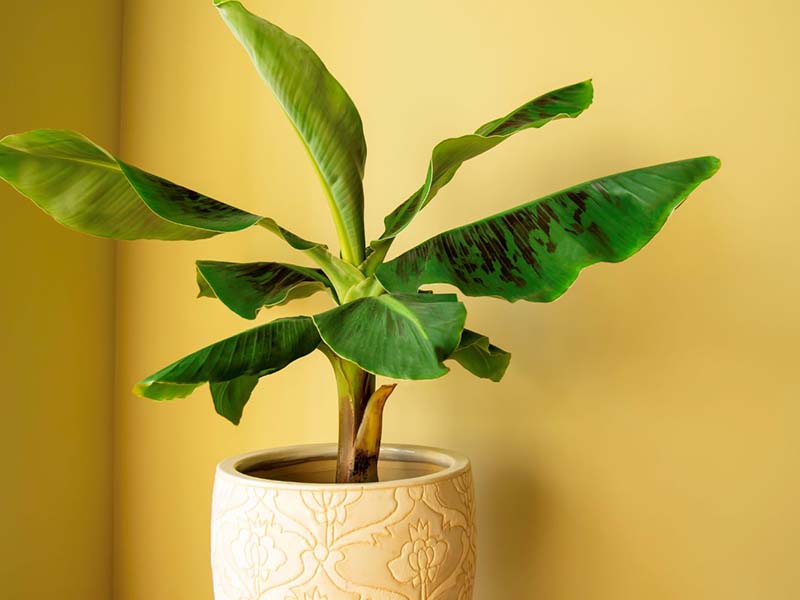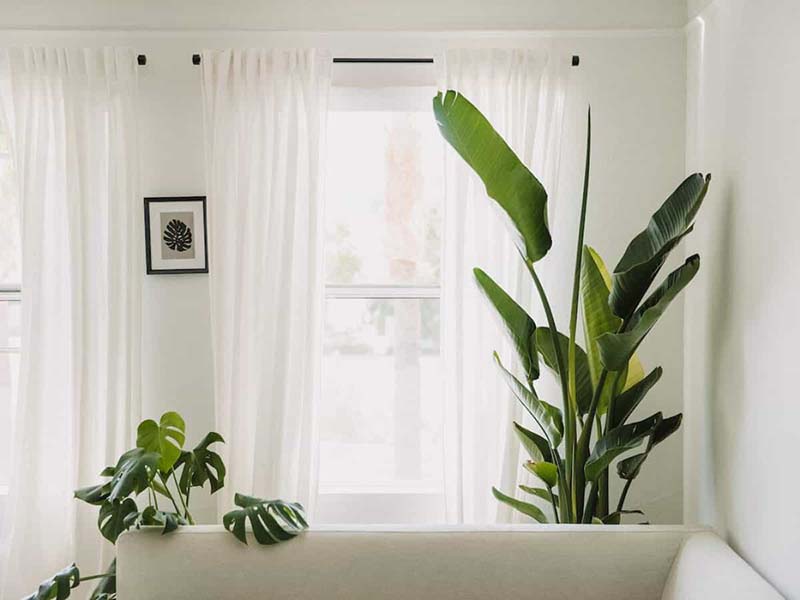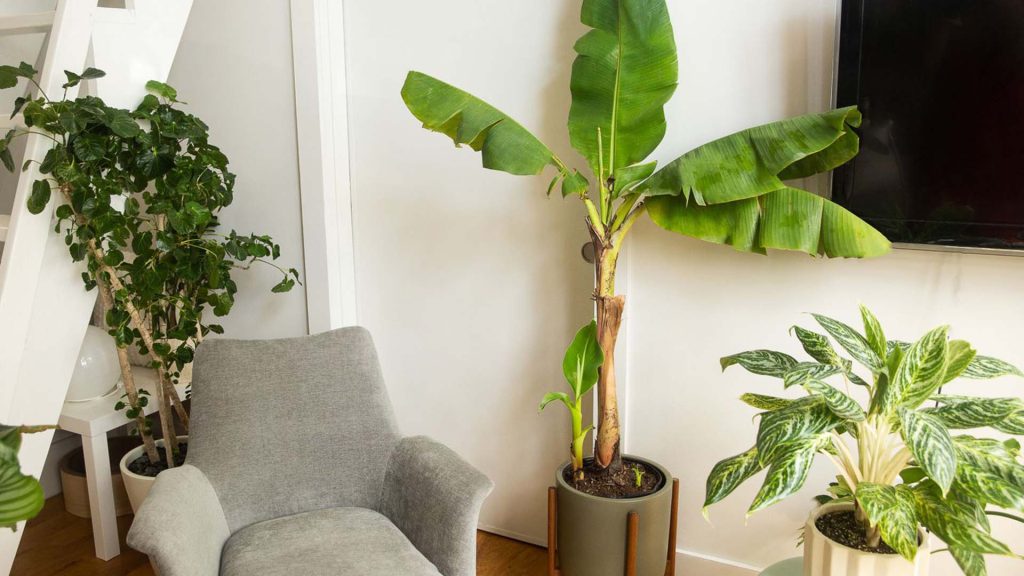An indoor banana plant is a perennial that belongs to the category of herbaceous plants. It can be grown as an ornamental or fruit specimen. Indoor banana plant has a fairly attractive appearance and is also characterized by ease of care, which provides it with a special value. Despite their exotic appearance, these tropical plants have just the most basic requirements; nonetheless, you must offer constant and enough care. Take some time to understand how to properly grow banana plants.
What Is a Banana Plant
Bananas come in a wide range of types and variations (Musa spp.). What does a banana plant look like? Even though these tropical fruiting plants are frequently referred to as trees, they are enormous herbaceous plants with no wooden stems. Instead, they have thick, erect stalks with huge, rectangular, brilliant green leaves that sprout from them. The showy blooms bloom in the spring, giving way to the juicy, green, or yellow fruit in the summer.
There is a banana tree that will fit in any size yard or residence. They also make fine houseplants if given enough light, however, they don’t usually yield fruit inside. Bananas are fast-growing plants that should be planted in the spring. Today we will learn how to grow a banana plant, and how to properly care for it to get a beautiful and healthy plant.
Types of Banana Plants
There are more than 70 types of banana plants known today, but we want to tell you about the most popular and easy-to-care options.
- Musa acuminata: This species grows to a height of 12 to 20 feet and is prized for its attractive foliage, which has paddle-shaped leaves that may grow to be 6 to 10 inches long.
- Musa ornata: This species, sometimes known as the blooming banana, is mostly farmed for its decorative appeal; its little fruits are rarely eaten.
- Musa basjoo: This plant, sometimes known as the Japanese banana, is cold tolerant and grows to a height of 6 to 14 feet.
How to Care for the Banana Plant

Light
On most days, most species of banana plants prefer to grow in full sun (at least 5-6 hours of direct sunshine). Some types, on the other hand, are prone to scorching and can thrive in partial shade.
Soil
These plants thrive in organically rich soil with a slightly acidic soil pH and proper drainage. They have a limited tolerance for salt in the soil.
Watering
How often to water banana plants? Banana plants in spring and summer require generous watering, without stagnant water in the trays and with a slight drying of only the very top of the substrate. For the winter, the humidity is greatly reduced, carrying out light and rare watering, maintaining a stable moisture content of the substrate, but allowing it to dry well in the upper part.
At any time of the year, watering can be done only with soft, slightly warm water. Maintaining the right humidity level is also an essential part of caring for this amazing plant. For the normal development of bananas, you need to create an environment with tropical air humidity – not lower than 70%. Luckily, bananas are not too picky about persistence in this parameter: they can withstand short drops and fluctuations in humidity.
Of course, installing humidifiers and creating a controlled microclimate is the best option. Even pallets with moss or expanded clay will do. Also, do not forget to take care of the leaves of the banana plant. So that the leaves of banana plants do not lose their luster and do not dry out, in a room format it is enough to carry out frequent spraying, showering, and rubbing with a damp sponge (at least 1 time per week).
Temperature
These plants can grow in warm, humid conditions, but not in extremes of temperature. Even the hardy varieties require temperatures of 75 to 95 °F regularly. But avoid too low temperatures and dry conditions, as this can lead to the death of the plant.
Fertilizer
Add a balanced fertilizer regularly during the growing season, as directed on the package. To increase the amount of organic matter in the substrate, you can sprinkle compost into it at least once a year.
Repotting
Banana is fast-growing, so it needs to be repotted periodically. It is better to do this in the spring, picking up a more capacious pot. A layer of drainage must be poured at the bottom of the container. When transplanting a banana, it is always buried deeper than the previous time. This is done to stimulate the emergence of new roots.
How to Propagate a Banana Plant

The division is the most effective technique of dissemination. With a sharp shovel, detach the suckers from the rhizome (horizontal subterranean stem) to divide banana plants. Before doing this, wait till the suckers have their roots and are at least 3 feet tall. Allow a day or two for the surface of the rhizome portion to dry after separating a cutting from the parent plant. It will be ready for transplanting in any suitable place at this stage.
Planting a Plant
Banana plants may be grown in pots, but for the best development, they need at least a 15-gallon pot. The pots should have drainage holes. You will be able to bring your banana indoors to protect it from cold and stormy weather if you pot it. Potted plants, on the other hand, have higher watering and feeding requirements since they use up the restricted soil in their pots quicker than those in the ground. Furthermore, they are unlikely to attain their full potential and may not yield fruit. Despite this, many people enjoy them because of the gorgeous foliage.
How Fast Do Banana Plants Grow
With proper care during the year of growth, it can add about 3 ft. The lifespan of an indoor banana is quite short – just about 6 years, and the maximum banana plant height is about 10 feet. For the first time, the bush blooms no earlier than the age of three. At the top of the trunk, an inflorescence is formed in the form of a cone.
Banana Diseases and Pests
Under ideal conditions, banana plant health is not a problem. Indoor bananas rarely get sick, suffering from rot under the condition of improper lighting, temperature, and humidity. And you will not meet pests even on very neglected plants. Restoring normal substrate moisture, and eliminating drafts and hypothermia are the main means of combating decay, along with an emergency transplant. Still, plants are easier to replace than to save.
A banana plant is an excellent choice if you want massive, attractive, lush tropical plants with large, striking greens. There are a variety of hardy banana plants to pick from, allowing you to acquire a great collection of different types if you wish.


